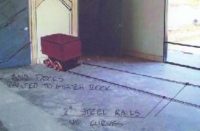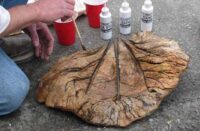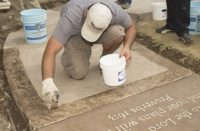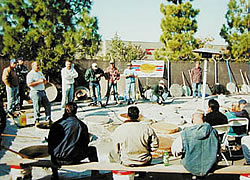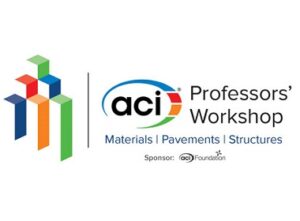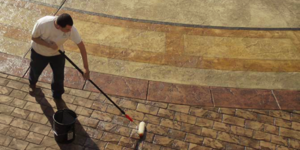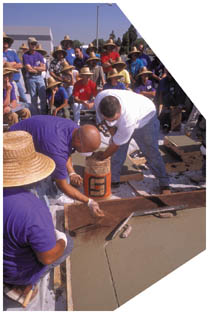 Regardless of what line of work you’re in and how experienced you are, there are always new skills and techniques to learn that can help you improve your reputation and profitability. Just as doctors, musicians and other professionals can broaden their opportunities and increase their earnings potential by mastering specialized instruments and procedures, concrete contractors can greatly enhance their chances for bright and prosperous careers by taking advantage of the many learning opportunities offered within the industry.
Regardless of what line of work you’re in and how experienced you are, there are always new skills and techniques to learn that can help you improve your reputation and profitability. Just as doctors, musicians and other professionals can broaden their opportunities and increase their earnings potential by mastering specialized instruments and procedures, concrete contractors can greatly enhance their chances for bright and prosperous careers by taking advantage of the many learning opportunities offered within the industry.
These days, one of the hottest trends in the world of concrete is the proliferation of decorative concrete. Concrete that is enhanced through the use of integral colors, saw cuts, stains, polymer overlayments, stamping, texturing, and antiquing, to name just a few of the available options.
Of course, concrete has been around for centuries. It has a proven track record as a durable, reliable, and functional material. Using decorative concrete for all kinds of buildings, roads, bridges, floors, driveways and so forth. But until recently — roughly 25 years ago — concrete wasn’t very aesthetically pleasing because of its bland, gray hue. Since then, dozens of manufacturers in the concrete industry have introduced products and systems designed to transform boring monotonal slabs into unique, eye-catching, distinctive surfaces, both interior and exterior, in a broad range of applications.
Increasingly, this segment of the market has been promoted to architects, landscape designers, interior designers and consumers to such an extent that decorative concrete is experiencing a virtual explosion in growth and popularity. From commercial uses in theme parks, resorts, hotels, restaurants, malls and office buildings to residential applications for patios, pool decks, driveways and sidewalks, decorative concrete is clearly on a roll.
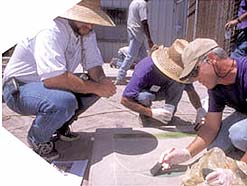 Where to Learn the Techniques
Where to Learn the Techniques
For the lifelong veteran of concrete installation as well as for the novice looking to enter the profession, the demand for decorative concrete presents a challenge: How do you best learn the necessary skills and techniques required for high-quality results? On-the-job training is simply not practical. Due to the very nature of concrete and the prohibitive cost of having to rip out and re-do unsuccessful treatments.
The good news is that, as demand for quality decorative concrete has soared, so have the opportunities for learning the applicable skills. A broad range of seminars, workshops, training sessions and similar educational opportunities is now available on a regular basis in virtually every region of the nation, and other parts of the world as well. Dozens of manufacturers of decorative concrete products and systems now offer decorative concrete training programs as often as several times monthly. Other opportunities, such as World of Concrete and other annual shows, also sponsor demonstrations in the latest techniques.
However, for the concrete contractor interested in acquiring decorative finishing skills, the range of choices of educational offerings can be vexing. Do you know what to look for? How do you separate the quality program from the so-so? How do you know if your time and/or money are being spent wisely? In other words, how do you find the training program that will bring the results you’re looking for?
Concrete Decor recently spoke with representatives from a number of companies who provide seminars in decorative concrete techniques, asking them to share their views on this market niche, how it has evolved, where it’s headed, and how these instructional opportunities can help raise the standard of quality demanded by customers and delivered by practitioners.
An Emerging Niche Market
It’s generally agreed that, although there may have been earlier applications, the 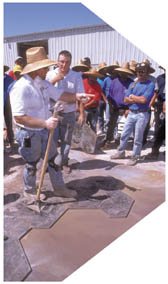 first major mainstream use of decorative concrete occurred in the theme parks of the Sun Belt — Disneyland, Disney World and Sea World, among others. Robert Harris, a third-generation concrete finisher, was an integral player in the installation of much of the decorative concrete at Disney World in the late 1970s. “I’ve been in the concrete industry virtually all my life, working with my dad, who worked with his dad, and I was very fortunate to serve a sort of apprenticeship in the theme park environment,” he recalls. “I worked with the Disney architects, who are so creative. They would come up with a concept and design it, and then turn it over to craftsmen like me to implement the design into concrete pavement. They have virtually every color, texture and design you can think of.”
first major mainstream use of decorative concrete occurred in the theme parks of the Sun Belt — Disneyland, Disney World and Sea World, among others. Robert Harris, a third-generation concrete finisher, was an integral player in the installation of much of the decorative concrete at Disney World in the late 1970s. “I’ve been in the concrete industry virtually all my life, working with my dad, who worked with his dad, and I was very fortunate to serve a sort of apprenticeship in the theme park environment,” he recalls. “I worked with the Disney architects, who are so creative. They would come up with a concept and design it, and then turn it over to craftsmen like me to implement the design into concrete pavement. They have virtually every color, texture and design you can think of.”
Most of the coloring systems used there, Harris said, were products of L.M. Scofield Co., a leader in architectural concrete for more than 85 years. He eventually joined the firm’s sales force and now serves as Director of Product Training for The Scofield Institute outside Atlanta, GA, where he runs “hands on” training seminars once or twice a month to groups of 20-25. “I’m very proud of my profession, and my main objective is to train people properly. We’re committed to helping the contractor be more effective; more successful in his own business. Decorative concrete is a very niche market, and that’s why it’s absolutely critical to provide quality, effective training.”
The decorative concrete market is actually comprised of two separate but related disciplines. Contractors can apply products and techniques to ready-mix concrete as it’s being poured and cured, and they can modify existing concrete slabs by adding polymer overlayments and then using various products and techniques on the overlayments to achieve the desired textures, colors and designs.
Manufacturers of polymer overlayments and related products typically limit their training programs to techniques that are meant to be applied to the overlayments rather than to new concrete. Dean Owen of Arizona Polymer Flooring Inc. says the two-day seminars his company offers focus on stamping techniques, acid stains and special coloring processes that are applied to the quarter-inch-thick polymer cements on top of existing concrete. “The stamping of polymer cement overlays on top of conventional slabs is getting to be a big part of the aftermarket treatment,” he observes. “It’s been on a roll for quite a while, and I don’t think it has peaked yet.”
Industry training programs range from one-day classes to special week-long offerings. Typically, seminars last two or three days — usually Thursday through Saturday. This is so attendees can take advantage of weekend travel options and to decrease time away from the job. As Harris explains, “In our industry, we have limited working time because of the outside elements and other factors, so we have found we need to keep it to three days and give them as much information as possible in that time frame.”
 Hands-On Training is Critical
Hands-On Training is Critical
Most instructors concur the best way for attendees to learn the required techniques is by doing, not watching. “We keep our class sizes small, no more than 25 or 30 people,” says Bob Williams, who schedules weekly seminars throughout the U.S. for StampCrete International Ltd., based outside Syracuse, NY. “We want them to leave here having learned the right way. It’s very important to get the hands-on experience, not just watch someone else do it. You’ve got to put the boots on and actually work with the products.”
Charles Leland, General Manager of SureCrete Design Products north of Tampa, FL, says, “Some people prefer to learn by watching, but we strongly encourage our people to roll up their sleeves and learn by doing. We put the tools in their hands because, ultimately, we want them to be successful.” Adds Harris, “It’s critical that each student get hands-on experience. Not just three or four out of 25. Everybody.”
Most programs include at least some classroom time up front and perhaps again at the end. Information is available to help attendees with marketing and business concerns during classroom time. However, the bulk of the typical seminar agenda covers pouring overlayments, selecting or conceiving a design, sawcutting, staining, placing and finishing fresh concrete, and working with color hardeners, release powders and stamping tools.
The concept of decorative concrete training seminars is relatively new. Virtually all the available programs are also new — less than 10 years old. Some programs are barely six months old. Consequently, it’s difficult to judge the quality of a program by how long it’s been in existence. Instead, prospective attendees should learn something about the depth of experience of the instructor. As in any school, your best teachers are the ones who really know their subject matter. The person conducting the seminars should be an experienced finisher who is still active in the business.
At The Stamp Store in Oklahoma City, OK, the three-day seminars are taught monthly. Bannister is another lifelong concrete guy who has been installing decorative concrete “since the early 1980s, before it was heard of much,” according to his colleague Linda Nicholas. “He has a lot of experience and he explains the techniques well. Attendees at our seminars are amazed at how much he knows and how easy it is to learn from him.”
Virtually all the seminars offered are sponsored by manufacturers of specific decorative concrete products and systems, and consequently, they don’t hide the fact that they hope their seminar participants will buy products upon completion of the program. Some require a minimum purchase, although most don’t. As Harris puts it, “At a Scofield seminar, I promote the use of Scofield products. Others promote the use of their products, and that’s only reasonable to expect. But I get angry when I hear people attend seminars where someone in a suit teaches them how to stamp concrete. That sounds more like a glorified sales pitch than real education in techniques. He’s not doing the industry any favors. Quality education leads to quality installations, which increases awareness and demand, which helps the industry as a whole.”
Various Seminar Locations
Some programs, like Scofield’s, require attendees to travel to the manufacturer’s facilities. This may cost the attendees more in travel time and expenses. But it ensures an established, controlled environment, all necessary tools on site, and excellent preparation. Other programs, like The Stamp Store’s, split their time. Training at the manufacturer’s facilities or on actual job sites run by its installation company in the nearby area. The intention is to give participants a feel for on-site conditions and circumstances. Still others take their seminars on the road. Trainers travel to distributors’ facilities in convenient regional locations and inviting participants from that area. QC Construction Products, based in Madera, CA, conducts 15 seminars annually. Five of their seminars are in each of three regions (west, central, east), according to Western Regional Manager Kurt Johnson. Some manufacturers sponsor a combination of both “home” and “away” seminars.
A few manufacturers offer their seminars at no charge, saying they look at these programs as a customer service. Conversely, a few charge significant fees, sometimes requiring a commitment to purchase a minimum amount of product. Most, though, charge modest fees (anywhere from $75-$600 per person) not to make money but to cover costs. “We used to offer it for free. Sometimes people would back out at the last minute or fail to show up,” notes Leland of SureCrete. “If it is free, people sometimes perceive there’s no value.” Harris adds, “We don’t make any money on these courses. The fee covers meals, hotels, printed materials and all transportation except airfare.”
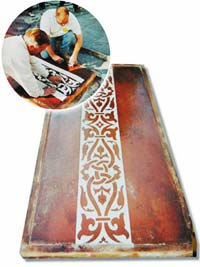 Who Typically Attends the Seminars?
Who Typically Attends the Seminars?
Naturally, the largest audience from which these programs draw their participants is concrete contractors. Secondly it is the distributors who serve the industry. “Our biggest clientele base is existing concrete contractors, from 30-year veterans to new apprentice-type employees,” says Harris. “They may want to learn new skills to take advantage of the additional revenue opportunities. Others may have been involved in decorative concrete for years but want to stay abreast of the latest techniques.”
Beyond that obvious market, program sponsors are also finding keen interest among architects and landscape designers. These industry professionals are excited about the potential of decorative concrete. They are eager to know more about the particulars of its installation. Additionally, according to Williams at StampCrete, swimming pool contractors have been attending. “They’re sick of subcontracting out the part of the job that calls for decorative concrete on the pool decks,” he observes. “In fact, we know pool guys who are now making more money stamping concrete decks than installing the pools.” Even ambitious do-it-yourselfers who want to decorate their concrete patios and sidewalks are signing up.
It’s a Bull Market
As in most growing markets, the future of decorative concrete appears very bright indeed. As awareness grows among architects, designers and consumers, and they specify decorative concrete in more and more applications, the demand for quality installers will increase commensurately, and, in turn, the need for quality instruction in stamping, texturing, staining and other techniques.
Even in cold-weather months, there are plenty of potential assignments in the field. “Decorative concrete countertops or interior floors are hot at the moment,” says Nicholas of the Stamp Store. “There’s good money in those kinds of projects.”
“Commercially, the field is really booming,” notes Williams. “Even residentially, it’s growing at a steady pace. There are some in this business who discourage the seminars because they feel it creates more competition for the available jobs. Most of us feel that the more people we have out there doing quality decorative concrete, the better. The more people who learn about it, the higher the demand will be.”
Various general and company-specific websites offer listings and other information. It is not always comprehensive, but they are a fine starting point for researching the available learning opportunities. Trade magazines are also great resources; indeed, this and future issues of Concrete Decor feature a number of advertisements from firms touting their training programs.
And if you’re a contractor thinking of attending a seminar, here is something to consider. Once you’ve completed your training, you may get job leads from the manufacturer. “The people who attend our courses will likely end up with business leads from us,” says Harris. “We don’t endorse any one person, but we provide customers with a list of people from our training programs. All of them are qualified candidates to be considered.”
View the Decorative Concrete Training Guide to see upcoming training.
